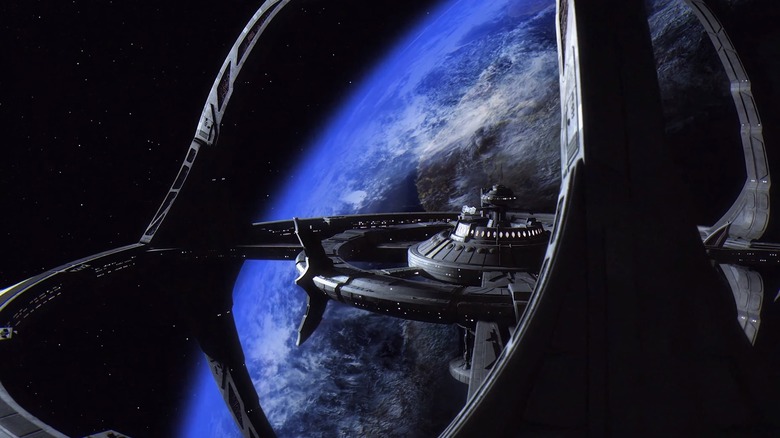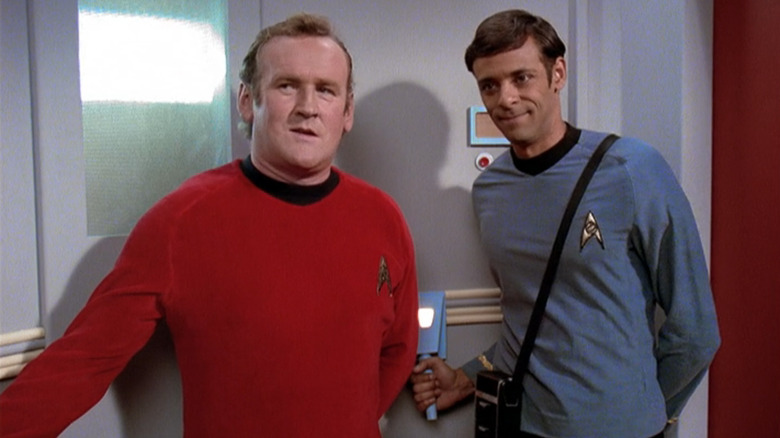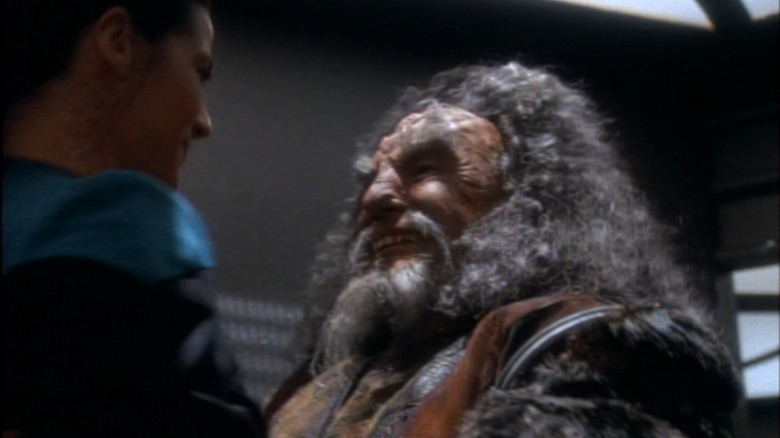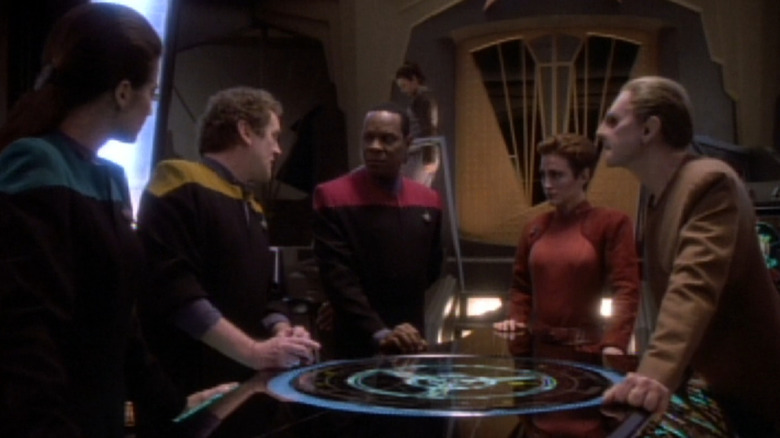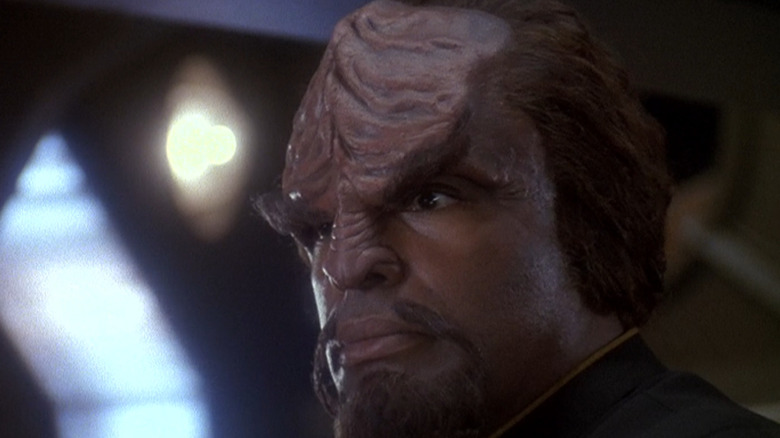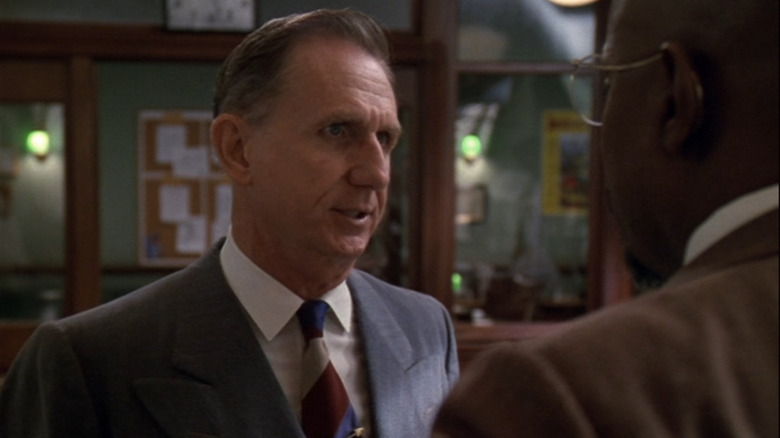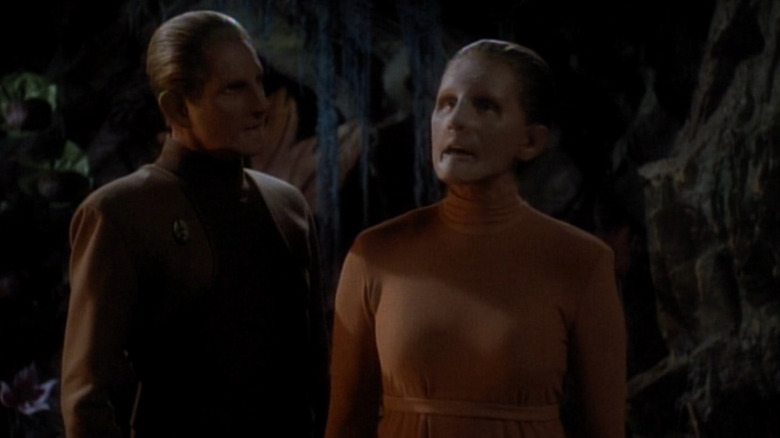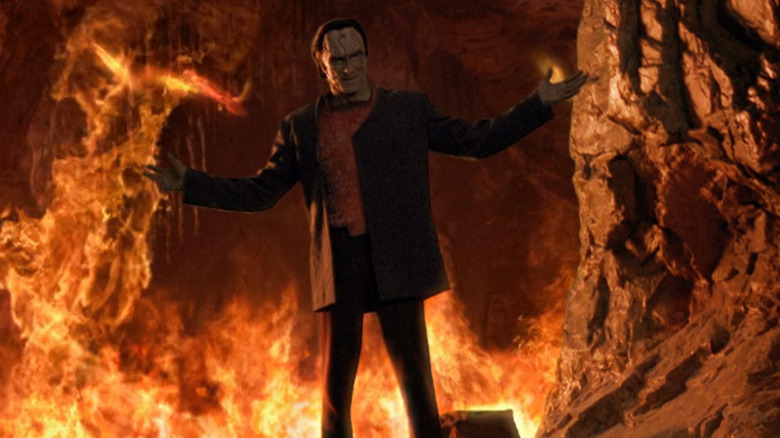Every Season Of Star Trek: Deep Space Nine Ranked Worst To Best
Characters on "Star Trek: Deep Space Nine" frequently like to speak in code or drop hints rather than get directly to the point, so let's be clear here. When it comes to "Star Trek: Deep Space Nine," worst is a highly relative term. In many, many ways, "Star Trek: Deep Space Nine" is the best "Star Trek." While it could never break the same ground as the original (and had a few clunker episodes due to its longevity and exhausted writers), "Deep Space Nine" tells the best story, has the best overall cast of characters, and its best episodes are more plentiful than those of most of its franchise brethren. Regularly dealing with moral compromises, no-win scenarios, and cultural differences that cannot always be bridged, it's the kind of show that might have dismayed original "Star Trek" creator Gene Roddenberry, who wanted the future of humanity to look perennially optimistic.
In the nihilistic '90s, however, when entertainment took a turn for the dark, even as the world seemed a little more hopeful, "DS9" put the optimistic, heroic figures of the Federation to the test. It's easier to be excellent to each other on a luxury liner like Jean-Luc Picard's "Enterprise-D" but tougher when you're essentially occupying the border between the outer space equivalents of Israel and Nazi Germany. The stories that ensued were compelling, thrilling, gritty, and amusing. With the caveat that none of the seasons was ever completely bad, these are the seasons of "Star Trek: Deep Space Nine" ranked worst to best.
7. Season 5
The highlight of Season 5 is undeniably "Trials and Tribble-ations," a then-unprecedented-for-TV use of "Forrest Gump"-style digital technology to insert the contemporary cast into an episode of the original series. With clever use of recreated sets, composites, and a smart script, "Trials and Tribble-ations is "Star Trek: Deep Space Nine's" "Rosencrantz and Guildenstern are Dead" to the original series' "Hamlet." (Fun fact: William Shatner's version of Hamlet's soliloquy can be heard alongside such songs as "Lucy in the Sky With Diamonds" on his infamous "The Transformed Man" album.) The episode also hilariously punted on the whole issue of Klingon makeup continuity from the '60s to the '90s, with Worf's (Michael Dorn) "It is a long story ... we do not discuss it with outsiders!" If only "Discovery" had as satisfactory a canonical excuse.
That (and a cameo from Iggy Pop as a Vorta) aside, Season 5 has many individual stories that seem like wheel-spinning in the larger Dominion arc. Jake (Cirroc Lofton) looks for a rare baseball card! Worf sympathizes with terrorists on a pleasure planet! Quark (Armin Shimerman) and Odo (René Auberjonois) bond! Keiko (Rosalind Chao) gets possessed! Rom (Max Grodénchik) and Leeta (Chase Masterson) become a thing! Not that these are inherently bad episodes — Dr. Julian Bashir (Alexander Siddig) undergoes a major character change when his past is revealed — but they're indicative of a major "Star Trek" weakness: the need to do character-driven episodes on a show in which the crew camaraderie is the thing. Without exception, every "Star Trek" series runs at maximum efficiency when it gives everyone something to do.
6. Season 2
Plot-wise, Season 2 is most significant for depicting the formation of the Maquis terrorist group and gradually introducing the Dominion, culminating in the season finale's introduction of the Vorta (who serve the Founders) and the Jem'Hadar (who serve as their footsoldiers). It also reintroduced the Mirror Universe, a setting that would recur several times during the series and allow the primary cast to play evil versions of themselves.
However, in popular culture, its most lasting contribution has been a popular meme on the correct way to greet someone who has come out as transgender. In the episode "Blood Oath," Jadzia Dax (Terry Farrell) meets three Klingons that she befriended in a past life when she was the male Curzon (all possible because humanoid bodies host a much longer-lived Trill symbiote). When she meets the Klingon Kor (John Colicos), he greets his old friend as "Curzon," leading Jadzia to gently correct him. She's Jadzia now. Kor promptly re-greets his old friend by her new name, with no fuss and no muss. "Star Trek" fans frequently cite this as an example of how to accept transitions properly. That all three primary Klingons in the episode are played by original series Klingon actors John Colicos, William Campbell, and Michael Ansara makes the episode all the richer.
5. Season 1
"Star Trek: Deep Space Nine" had a lot of heavy lifting to do to set up its corner of the universe. A station at the edge of known space made for a great hook, but the premise didn't stop there. A space station at the edge of known space, moderating an uncomfortable peace between the Bajorans, a highly spiritual people who'd suffered years of oppressive military occupation, and the Cardassians, a brutal and deceitful race finally bailing on the occupation.
Wait! There's more! By discovering and opening a nearby stable wormhole to the other side of the universe and making contact with a race of timeless beings who live inside the corridor, Federation Commander Benjamin Sisko (Avery Brooks) effectively becomes the Emissary, a messianic figure in the Bajoran religion. He doesn't want to be perceived that way, and many Bajorans are not okay with it either. However, the new role and assuming leadership over a mixed Federation-Bajoran crew just might help him get over the loss of his wife to the Borg.
Meanwhile, the station plays host to all manner of characters like the devious Cardassian tailor Garak (Andrew Robinson), the always quiet barfly Morn, and the congenitally dishonest Ferengi Quark (Armin Shimerman). Only in Season 2 would we realize the show was still holding its biggest card: the reveal of the Dominion, an evil equivalent to the Federation dominating the other side of the wormhole. It was a lot of world-building to pull off, and "Star Trek: Deep Space Nine" did it.
4. Season 4
In the beginning, not every "Star Trek" fan warmed to "Deep Space Nine." To boost ratings, the producers brought in Worf (Michael Dorn), previously a fan favorite on "Star Trek: The Next Generation," to add familiarity and encourage "TNG" fans to give the new show a try if they hadn't. To make Worf's addition in Season 4 make narrative sense, the show also brought back Klingons en masse and used the influence of the Dominion to make them antagonists again. Klingon leader Gowron (Robert O'Reilly), previously an ally of Captain Picard (Patrick Stewart), suddenly — but within character — became a dangerous opponent, while General Martok (J. G. Hertzler) became a new honorable ally with torn loyalties. Ultimately, he would accept Worf into his House as family.
This is also the season with Bashir's James Bond fantasy, Dax getting a same-sex kiss from a past-life female lover, the Ferengi becoming the Roswell aliens, and Tony Todd getting two separate and amazing parts. In one, the "Candyman" star plays an elderly Jake Sisko looking to change the past. In another, he's Worf's brother, Kurn, demanding to be honor-killed. Odo (René Auberjonois) bonds with Lwaxana Troi (Majel Barrett-Roddenberry), and Sisko must deal with the possibility that his girlfriend is a secret traitor. Though the season in some ways was kicking the Dominion War can down the road, it did so with compelling tangents.
3. Season 6
Season 6 finally delivers the Dominion War and with it "Deep Space Nine" at its best. Unlike in other fictional tales of wars in the stars, the battle takes a moral toll in addition to its body count, with Sisko forced into dilemmas of conscience, often knowingly making dishonest or destructive decisions in the service of the greater good. Gene Roddenberry might not have approved, but in the end, the resounding message is that war should be avoided, as it taints everything and everyone. On the other hand, fictional conflicts make for great entertainment.
However, what most fans remember the most from this season (and for good reason) is the episode "Far Beyond the Stars" in which Captain Sisko dreams that he's a 1950s sci-fi writer named Benny Russell, who pens tales of a fictional future space station. Unfortunately, they can't get published because of the perception that the public won't accept a Black captain in a science fiction story. Sadly, this appears to be a debate we still regularly have in cyberspace. Though the episode is unflinching in its depiction of racism, there's some comedic relief in the in-joke performance by Armin Shimerman as an aggressive parody of original series contributor Harlan Ellison.
Proving that not every season is perfect, we also got the debut of Vic Fontaine, a holographic lounge singer who'd wind up getting way more screen time than he deserved.
2. Season 3
It's one of the best twist payoffs of any sci-fi TV show when Odo finds his native race of shape-shifting Changelings, only to discover that they are the ruthless, racist Founders of the Dominion that we've heard so much about. Unlike many modern shows with their cheap surprises and cameos, this was a well-choreographed reveal. We knew Odo was found in space, probably having come through the wormhole. His shape-shifting power had narrative limits. Otherwise, he'd be too powerful. In hindsight, it should have been obvious he came from the most formidable race from that side of the universe. It was a bitter surprise that came with fascinating strings attached. Because no Changeling can harm another, Odo and his fellow Founders, while on opposite sides of a conflict, remained in a weird truce but only with each other. Allies were fair game. Odo's the last character fans would have expected to get seduced by a major villain, and yet...
Season 3 also introduced another great, underrated villain in Liquidator Brunt, the ruthless Ferengi determined to expose and punish Quark's every misdeed. One of many characters played by the great Jeffrey Combs, he's the only one who doesn't sound like the distinctive actor, thanks in part to large prosthetic teeth. Then, there is one of the best "Trek" future predictions ever: those Eugenics Wars never happened in the 1990s, but the racially charged Bell riots of the year 2024 sure look a lot like today.
1. Season 7
With current "Star Trek" shows, season-long stories are the norm. Even the supposedly episodic "Strange New Worlds" and "Lower Decks" now feature longer mini-arcs and callbacks to prior episodes. However, in 1998, it was radical. "Star Trek" shows were designed for syndication under the theory that episodes had to be reasonably stand-alone because most viewings would occur at a future date as one-offs or possibly, out of order. "Star Trek: Deep Space Nine" always depended slightly more on a bigger picture, but Season 7 made it into appointment TV, exciting fans about what might happen next and letting them wonder how the Dominion War could be resolved.
Jadzia Dax had been killed off the prior season. Nog lost his leg in this one. Sisko started to go insane on a quest to reopen the wormhole, and on Cardassia, Damar (Casey Biggs) finally turned on his bosses. Meanwhile, a new alliance of evil formed between a surgically altered undercover Gul Dukat (Marc Alaimo) and rejected Bajoran fundamentalist Winn. A recast Dax (Nicole de Boer as Ezri Dax) managed to charm fans in record time and weirdly resolve her romantic inclinations towards Worf and Bashir.
Sure, there were occasional silly holosuite diversions like the baseball game, but even the overused Vic Fontaine got his best moment as Nog's de facto PTSD counselor. Most importantly, though, the show stuck the landing with a glorious space battle finale and Sisko finally tossing Gul Dukat, the greatest "Star Trek" villain ever (sorry not sorry, Khan!), into an inferno.
